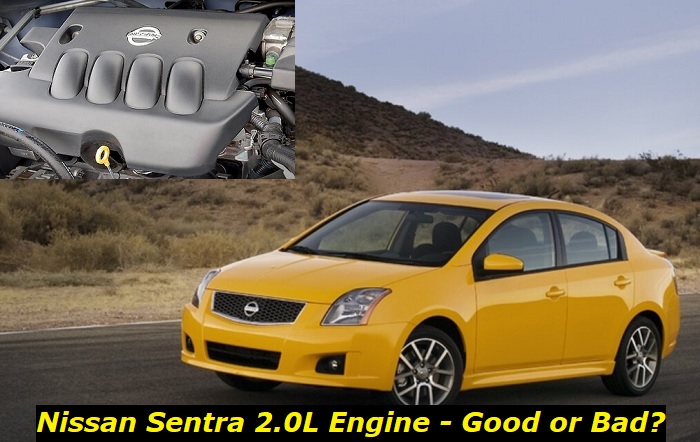A lot of our readers are curious about the Nissan Sentra engine released from 2006 to 2012, the one with 2.0L displacement. So, we decided to dive deep into this engine to share more information and search for problems that occurred among the owners.
See, the successor of the QR20DE is one of the simplest yet reliable engines produced today. Nissan started manufacturing the engine in 2005, and the production continues today. Many of these engines are still running and in good shape.

It has catered to over 15 Nissan and Renault car models. In this article, we will talk about the first engine released from the 6th generation of B16 engines for Nissan Sentra, the Nissan Sentra MR20DE or Renault M4R.
Key features and my opinion about the engine
- Production years:2005-2020
- Average lifespan of MR20DE:220,000-250,000 miles
- Fuel supply type:port injection
- Power range:133-147 hp
- Fuel efficiency:average
- Engine block material:aluminum
- Engine reliability score:medium
- The most common problems:bad oil consumption, weak timing chain and phaser, bad and failing sensors, very soft engine head metal.
What do I Need to Know About the 2L, 6th Generation, B16 (2006 to 2012)?
MR20DE belongs to the family of Nissan MR engines. The MR20DE stands for:
- MR- The engine family where it belongs.
- 20- The engine has a 2.0 Liter displacement.
- D- The engine utilizes DOHC or Dual Overheard Camshafts)
- E- Multi-point Fuel injection System
Nissan produced this engine at the Yokohama plant, making it a classic Japanese School power engine. The manufacturer initially installed the engine on Nissan Qashqai and Nissan X-Trail.
Also, you can find this engine on certain Renault cars, and they coded the engine as M4R. The MR family series is a collaborative project between Nissan and Renault. All Nissan MR engines have four cylinders with four valves each, totaling 16 valves encased in an all-aluminum lightweight block utilizing a Variable Valve Lift technology. It also has aluminum cylinder heads and cast-iron cylinder liners.
Distinct from the MR engines are the intake manifold' tumbler control valve, crankshaft with a mirror finish, cylinders positioned offset on the crankshaft, and a quiet timing chain.
With an offset positioning, the connecting rod angle reduces friction as the piston goes down to the cylinder. This kind of reciprocating motion improves power output and increases torque. Its design allows the piston to pause a bit more while on the upper part, so its velocity would slow down.
With Dual Overhead Camshafts (DOHC), the MR20DE uses multi-rollers where solid pushers carry out variable valve timing. And with the hydraulic lifters' absence, you must adjust the valve clearance when you hear ticking noises.
The engine consists of a plastic intake manifold with a tumble control valve and a steel exhaust manifold. Intake and exhaust should flow freely, as they are designed to create minimal resistance. The MR20DE utilizes an Exhaust Gas Recirculation, wherein part of the exhaust gas returns to the intake side so that emission minimizes and fuel consumption reduces.
It utilizes distributed fuel injection system. Its piston stroke measures 90.1 mm, and the cylinder bore measures 84 mm. The compression ratio of this engine is 10:2:1. The cylinder firing order is 1-3-4-2.
The engine generates power between 133 and 147 hp.
- 133 hp at 5200 RPM
- 137 hp at 5200 RPM
- 140 hp at 5100 RPM
- 147 hp at 5600 RPM
MR20DE produces torque between 191 and 201 Nm.
- 191 Nm at 4400 RPM
- 196 Nm at 4400 RPM
- 193 Nm at 4800 RPM
- 201 Nm at 4400 RPM
Use gasoline for this engine. Unleaded fuel will do.
The recommended oil for this engine is 5W-30, but you can also use 0W-20 or 5W-40. Change oil intervals are between 5,000 to 10,000 miles. It would likely consume a quart for every 1,200 miles.
How Long Does the 2.0 L, Nissan Sentra MR20DE Renault M4R Last?
The MR20DE is a reliable machine. Because of its structure and design, its owners may enjoy the car until its declared serviceable mileage.
- It should be able to show signs of damage at 150,000 miles when maintained properly.
- The MR20DE timing chain should last about the mileage of 150,000 miles.
- You may need to adjust the valve clearance every 60,000 miles.
At up to 15,000 miles mileage every year, the car may last up to 15 years or more with proper maintenance.
What are the Common Problems of Nissan Sentra MR20DE Engines?
However, with continuous use and several factors on usage and maintenance, this powerful engine could have some flaws and issues.
- It consumes a lot of oil.
A lot of owners complain about the engine's high consumption of oil. Soot could build up in the cylinder or O-rings may block it. Go to your trusted mechanic for diagnostics. They may recommend decarbonization or overhaul. To prevent this, carefully select your oil.
- Engine knocking
Engine knocks happen when the combustion does not take place at the right time on a four-stroke cycle, resulting in fuel burning prematurely or at random parts of the cylinder.
You can hear engine knocks at times. If you've been hearing this, your valves need clearance adjustment.
In an MR20DE, the clearance should take place every 60,000 miles. The recommended clearance adjustment for the intake valve is around 0.26 - 0.34 mm for cold and 0.304 to 0.416 mm for hot. The recommended clearance adjustment for the exhaust valve is 0.29 to 0.37 mm for cold and 0.308 to 0.432 mm for hot.
- Rough Idling
There are many causes for rough idling in cars. But rough idling on an MR20DE is a common occurrence.
Rough idling leads to power loss, and with timing chain noises, the chain could have been stretching. If your timing chain is in this state, you should replace it. Moreover, this problem could be due to the grimy throttle body. If it does, you would also have to replace it.
- Whistling sound
Hearing whistling noises while driving is not only annoying but troublesome.
If the squealing sound comes from under the hood, there should be improper tension anywhere in the drive belt system. If not, there could be grime on the belt. It has stretched out too much or has worn out excessively. All you need is to change the belt, and the noise should go away soon.
- Underdeclared timing chain lifetime
The timing system should last about the service vehicle's lifetime. However, the service time is usually shorter than that. Many owners of Sentra from 2006 to 2012 report their timing chain didn't get to its declared mileage. You may have to change it every 150,000 miles or less.
- Cracks on Cylinder head
In most cases, they use more than the needed torque when replacing the spark plugs. Also, the aluminum heads easily crack at high temperatures. The best thing to do is avoid too much force when changing spark plugs and replace them only on a cold engine.
How to tighten heads on an MR20DE:
- You will need these torque specs: 40Nm or 30ft-lbs or 4.1 kg.
- Turn your bolts by 100°.
- Remove all your bolts within these specs.
- Again, set these torque specs: 40Nm or 30ft-lbs or 4.1 kg.
- Turn your bolts by 100° twice, one at a time.
Of course, it's always better to have it done by professionals.
- Floating speed of the engine
The throttle is essential to the air intake system as it is essential in the efficient combustion of fuel. Many Nissan Sentra owners complain of their cars jerking or floating at idle speed.
- Power drop
Dips in power usually occur when there's an increase in temperature. Your vehicle may experience power loss because the mass air flow sensor receives the wrong signals from the air temperature sensor. Sometimes these sensors accumulate dirt and rust, resulting in a false reading. You can avoid this by regularly cleaning the sensors.
MR20DE Engine Tuning
Thinking about tuning an MR20DE would probably be a bad idea. The engine is not tuner-friendly, and finding parts that work on it would be a real challenge. But if you like the idea, you can improve this engine. Here are our recommendations:
- Fast road camshafts- The top-end power will increase, and your low-end power will decrease.
- Mapping- These are the secrets: remapping, piggybacking, and aftermarket ECU to improve your gains.
- Upgrades on intake and exhaust- Purchase cold air intake to remove restrictions.
- Custom header- You will need this again so that air can get into the vehicle and remove the restrictions.
- Turbo upgrades- This one can get costly, but there is none better than increasing your air supply to generate more power.
However, you do not have to do this as this engine is not for tuning. Well, you can do it if you are bored and have more money to spend.
How to Maintain your Nissan Sentra MR20DE?
The secret to keeping your MR20DE in shape is to perform regular maintenance. You can avoid the problems and have healthy timing belts, sensors, cylinder heads, and a well-conditioned engine.
Here's what you should do:
- Change your oil and oil filter every 4,500 miles.
- Replace the air filter every 9,000 miles.
- Replace your spark plugs every 50,000 miles.
- Change drive belts every 50,000 to 100,000 miles.
- Replace coolant every 30,000 miles.
- Replace the timing chain every 120,000 miles.
- Adjust valve clearance every 60,000 miles.
Is the 2.0L MR20DE engine reliable?
Of course, it is. It has a simple structure and is almost free of flaws. With the combined engineering of Renault and Nissan, you are sure the engine has been well-researched and developed. And while they still produce the engine, most issues are already addressed. It all takes a little part from the owner to keep the engine in good shape and enjoy its service life.
About the authors
The CarAraC research team is composed of seasoned auto mechanics and automotive industry professionals, including individuals with advanced degrees and certifications in their field. Our team members boast prestigious credentials, reflecting their extensive knowledge and skills. These qualifications include: IMI: Institute of the Motor Industry, ASE-Certified Master Automobile Technicians; Coventry University, Graduate of MA in Automotive Journalism; Politecnico di Torino, Italy, MS Automotive Engineering; Ss. Cyril and Methodius University in Skopje, Mechanical University in Skopje; TOC Automotive College; DHA Suffa University, Department of Mechanical Engineering






Add comment